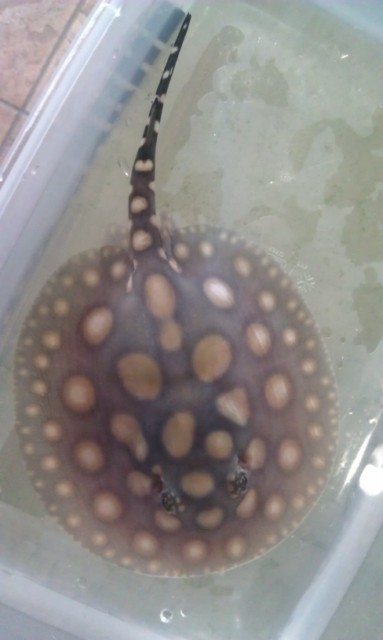The Center for Stingray Biology is a subsidiary of the Institute for Herpetological Research, a non-profit research organization founded in 1973 by Dr Richard Ross. The Center is dedicated to the study of all aspects of freshwater stingray husbandry. Current breeding projects include Potamotrygon leopoldi, P. henlei, the P14 Itaituba ray, P. falkneri, the black diamond morphs of P. leopoldi, and the pearl rays. Our work also includes studying the nutritional and water quality requirements of freshwater stingrays.
Any question maybe directed to: stingraybiology@gmail.com
Any question maybe directed to: stingraybiology@gmail.com
Tuesday, November 8, 2011
Wednesday, June 29, 2011
Saturday, March 5, 2011
Fiberglass tanks for New Facility
Here are a couple of videos showing the loading of our new fiberglass tanks to be delivered to our new facility.
Thursday, February 3, 2011
Wednesday, January 26, 2011
Monday, January 24, 2011
Leopoldi returns from Sea World
One of the Leopoldi stingrays that the Institute donated to Sea World over 7-8 years ago has now returned home. She was graciously returned to us and is all grown up now. She will make for an excellent breeder. Here is a pic of her as we were leaving Sea World.
Current Publications by the Center
Aqualog Freshwater Rays
This AQUALOG volume represents the first comprehensive publication in the popular literature to cover all the rays living in fresh and brackish water, with full coverage of:
- the sawfishes (Pristidae)
- the guitarfishes (Rhinobatidae)
- the South American freshwater stingrays (Potamotrygonidae)
as well as all the representatives of the electric rays (Torpediniformes), eagle rays, mantas, etc (Myliobatidae), and whiptail stingrays (Dasyatidae) that are known to enter fresh or brackish water.
An identification key for all the species is provided. The aquaristically significant freshwater stingrays are depicted in colour photos illustrating a never-before-seen panoply of species and colour varieties. All the other species are likewise illustrated as never before.
Splendid biotope photos from the natural habitats of these rays round off this superlative volume.
This book thus presents an indispensable reference work for anyone interested in rays - aquarists, zoological gardens, scientists, and divers.
Aqualog Special
The extremely detailed text is illustrated with more than 80 unique photos, making this an indispensable book for anyone who wishes to know more about these interesting creatures or who is keeping - or planning to keep - stingrays in an aquarium.
Freshwater Stingrays - A Pet Owner's Manual
- the sawfishes (Pristidae)
- the guitarfishes (Rhinobatidae)
- the South American freshwater stingrays (Potamotrygonidae)
as well as all the representatives of the electric rays (Torpediniformes), eagle rays, mantas, etc (Myliobatidae), and whiptail stingrays (Dasyatidae) that are known to enter fresh or brackish water.
An identification key for all the species is provided. The aquaristically significant freshwater stingrays are depicted in colour photos illustrating a never-before-seen panoply of species and colour varieties. All the other species are likewise illustrated as never before.
Splendid biotope photos from the natural habitats of these rays round off this superlative volume.
This book thus presents an indispensable reference work for anyone interested in rays - aquarists, zoological gardens, scientists, and divers.
Aqualog Special
In the rivers and lakes of tropical South America lives a group of fishes that are more often associated with the sea - stingrays. Although in their natural habitat they are feared much more than the piranhas, on account of their dangerous poisonous spines, all over the world increasing numbers of enthusiastic aquarists are succumbing to the fascination of these unique creatures.
Dr Richard Ross, a scientist at the Santa Barbara Zoo in America, has for a long time been keeping these fishes in the display aquaria at the zoo, and here publishes the vast store of knowledge derived from this experience. The requirements of these rays, as regards successful maintenance and breeding, are revealed in detail for the first time in the literature. The reader will learn all about the requisite tank size, how to set up an aquarium for rays, the correct water parameters, and breeding. The successful diagnosis and treatment of diseases that affect rays is also covered in detail. In addition the different species groups and their pecularities are discussed. The extremely detailed text is illustrated with more than 80 unique photos, making this an indispensable book for anyone who wishes to know more about these interesting creatures or who is keeping - or planning to keep - stingrays in an aquarium.
Freshwater Stingrays - A Pet Owner's Manual
An excellent basic guide to the maintenance of freshwater Stingrays in home aquaria with complete information on basic aquarium setup, equipment, feeding, sex determination, breeding, health care, and stingray acquisition. Also include are brief examinations of the taxonomy, anatomy, and stings of freshwater Stingrays, and a review of several Stingray species requiring special care and beautifully illustrated with 93 color photographs and additional b/w photos and drawings.
Subscribe to:
Posts (Atom)




















